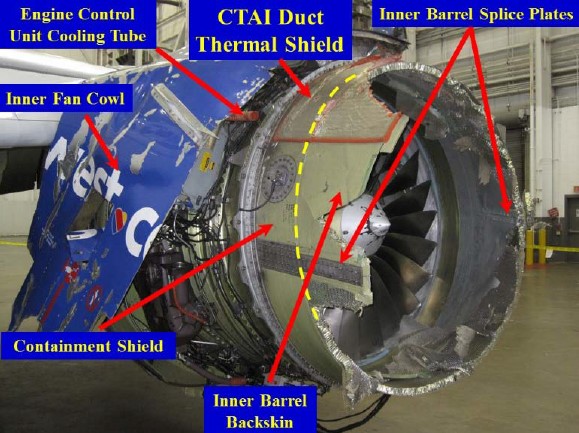US safety investigators have released photos of the of the shredded engine from a fatal Southwest Airlines flight and say the aircraft suffered significant damage as it was peppered with shrapnel.
Investigators found damage to the leading edge of the left wing, the fuselage and the left horizontal stabilizer as the outing covering and engine inlet disintegrated.

The aircraft, which had been flying from New York to Dallas, made an emergency landing in Philadelphia.
The incident became the first fatal US commercial aircraft accident since 2009 after bank executive and mother of two Jennifer Riordan was partially sucked through a window next to her seat.
READ: Southwest victim Jennifer Riordan a force for good.
Flight attendants and two male passengers managed to bring o bring her back into the aircraft but she died of blunt trauma injuries suffered during the ordeal.
An investigative update issued Thursday by the National Transportation Safety Board points to a large piece of engine cowling as the debris that hit the fuselage near the window.
Investigators said a large gouge impact mark, consistent in shape to a recovered portion of fan cowl and latching mechanism, was adjacent to the row 14 window.

Media initially assumed the window had been shattered by debris but the report said the entire window was missing and no window, aircraft structure or engine material had been found in the plane.
Investigators confirmed the damage resulted from the failure of number 13 fan blade, which separated at the root, and revealed they had recovered two pieces within the engine.
They found fatigue cracking in the blade, which had seen more than 32,000 landing and take-off cycles since new.
Investigators said the blades had been periodically lubricated as per the manufacturer’s specifications and were last overhauled in November, 2012 — some 10,712 engine cycles before the accident.
They were inspected during the 2012 overhaul using visual and fluorescent penetration inspections and had been visually inspected during six subsequent lubrications. Southwest had also introduced eddy current inspections after a similar fan blade failure in 2016.
“The NTSB materials group is working to estimate the number of cycles associated with fatigue crack initiation and propagation in the No. 13 fan blade and to evaluate the effectiveness of inspection methods used to detect these cracks,’’ the update said.
The flight crew told investigators the first sign of trouble after a normal climb out was when they experienced a sudden change in cabin pressure, aircraft yaw, cockpit alarms and a “gray puff of smoke.”
They quickly donned their oxygen masks and the first officer began a descent.
“Flight data recorder data showed that the left engine parameters all dropped simultaneously, vibration increased, and, within five seconds, the cabin altitude alert activated,’’ the update said.
“The FDR also indicated that the airplane rolled left to about 40 degrees before the flight crew was able to counter the roll with control inputs.
“The flight crew reported that the airplane exhibited handling difficulties throughout the remainder of the flight.
“The captain took over flying duties and the first officer began running emergency checklists. The captain requested a diversion from the air traffic controller; she first requested the nearest airport but quickly decided on Philadelphia.’’
The captain was planning a long final approach but decided to shorten it and expedite landing after learning of the injuries to Riordan.
























